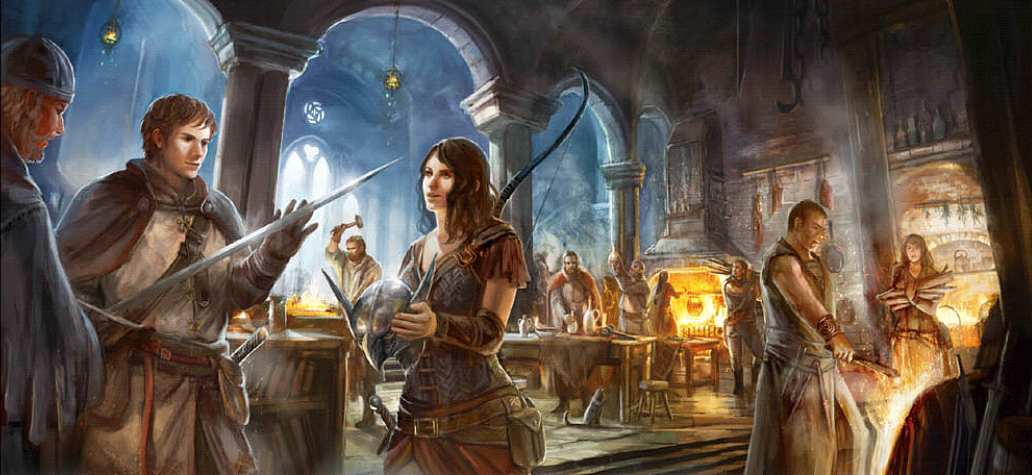Dragon's Dogma: Items and Equipment

Now that we have a good handle on the locations and characters of Gransys, let’s take a look at its stuff. This means both the gear available to its delvers and the treasure that can be obtained from its dungeons. We’ll start with money, since that figures prominently in both categories.
Currency
The original game used a simplified currency system typical of electronic RPGs. The unit of currency was a generic “gold piece”. Early game items had 2-digit prices for consumables and 4-digit prices for equipment, going up to 5- and 6-digit prices respectively in the late game. Money was found in bags containing up to 10 thousand gold pieces either hidden in dungeons, or dropped from enemies. It could also be earned by selling items in town, and by the end-game selling unused equipment is the player’s main source of income.
We can afford to be a little more detailed in this adaptation. I want Gransys to have a currency system that fits more with the “dungeon fantasy” genre and if possible I also want to sneak a tiny bit of history in there like I did with the villages and baronies. This results in the following system:
Under Duke Edmun’s rule, Gransys has come to use coinage of several denominations. The copper penny is worth $1 in GURPS money, is about 23mm in diameter and weights 8 grams (125 to the kilogram). The silver shilling is worth $5, has a diameter of 15mm and weights 2.5 grams (400 to the kilogram). And the ducat is made of gold, worth $100, has a diameter a hair over 12mm, and weights 2.5 grams (400 to the kilogram). All of them are stamped with the Duke’s face on one side and with his coat of arms (a dragon with an exposed heart) on the other.
These coins are heavily used in Gran Soren and the smaller towns of Gransys, and also by merchants and nobles to conduct their business. They are less widespread among the common citizens in the baronies and villages, who make most of what they need themselves and barter with their neighbors for the rest. They might still own some money from trading with traveling peddlers, but it’s not unusual for it to be used solely for that purpose. Feudal lords at this level take their tribute in goods more often than in money.
These coin weights mean that the 10-thousand-coin “giant bag of gold” found in the orignal game would likely be a good deal smaller than its in-game graphic indicates, but would weight around 25kg and be worth $1,000,000! Needless to say, none but the most fabulous treasures have that much gold in them. The same weight of silver would be worth $50,000, or $10,000 if it’s copper. Most hoards will likely be mixed.
PCs can also find variant coins, with different sizes or even made of different materials. These can come from the neighboring nations or from the ancient depths of some dungeon. See GURPS Dungeon Fantasy Treasures 1: Glittering Prizes for inspiration. “Money changer” isn’t an official occupation in Gransys, but many a wealthy merchant or collector would be glad to perform the service for a friendly fee.
Mundane Equipment
As mentioned before, Gransys is mostly a TL 4 setting, with transportation and information technology still at TL 3. What this means to delver PCs is that the list of gear available to them matches the one from GURPS Dungeon Fantasy pretty much exactly.
Those groups who want to go into a little more detail here are encouraged to use the weapon and armor tables from GURPS Low-Tech instead of the ones from the Basic Set, especially for armor. This will generally result in lighter but more expensive armor, which matches up a bit better with the “realistic Middle Ages” vibe the setting gives off. And even though only the European Low-Tech weapons are appropriate for a Gransys game, that will still increase the amount of possible choices for players.
Gransys towns carry basic mundane equipment and may have a few of the simpler weapons. Special orders and more elaborate weapons and armor are always available in Gran Soren, and may be available in towns on an individual basis. Manors might provide a limited selection of basic gear, but most villages will be unable to spare anything other than some food.
Magic Items
Magic items merit some special discussion. Like in standard Dungeon Fantasy, their making is the province of NPCs, but here these aren’t scholarly (or priestly) enchanters. Instead, they’re artisans who have mastered the secrets of their craft. These secrets are effectively a form of alchemy, and a master artisan might be as eccentric as any powerful magician. Still, they usually get more respect than a powerful spell caster, who is likely to be seen as sinister and feared for his powers.
Magic items are available in Gran Soren at the same prices quoted in Dungeon Fantasy 1. This includes alchemical concoctions, available from apothecaries. It might be possible to buy such things in smaller settlements if the GM thinks they might be home to a sufficiently skilled artisan.
Anything not listed as available for sale in DF 1 is either an ancient artifact that has to be pried from a ruin or monster, or the work of a true master of the sort who hides away from the world and places absurd demands on prospective customers. Either way, it requires adventuring to get!
At the top end, most of the Artifacts from Dungeon Fantasy 6 and similar sources would be appropriate for inclusion in the game. They would obviously only be available as hard-to-find loot.
In the next article in this series, we’ll take a look at one of the original game’s most distinctive subsystems - equipment upgrades!